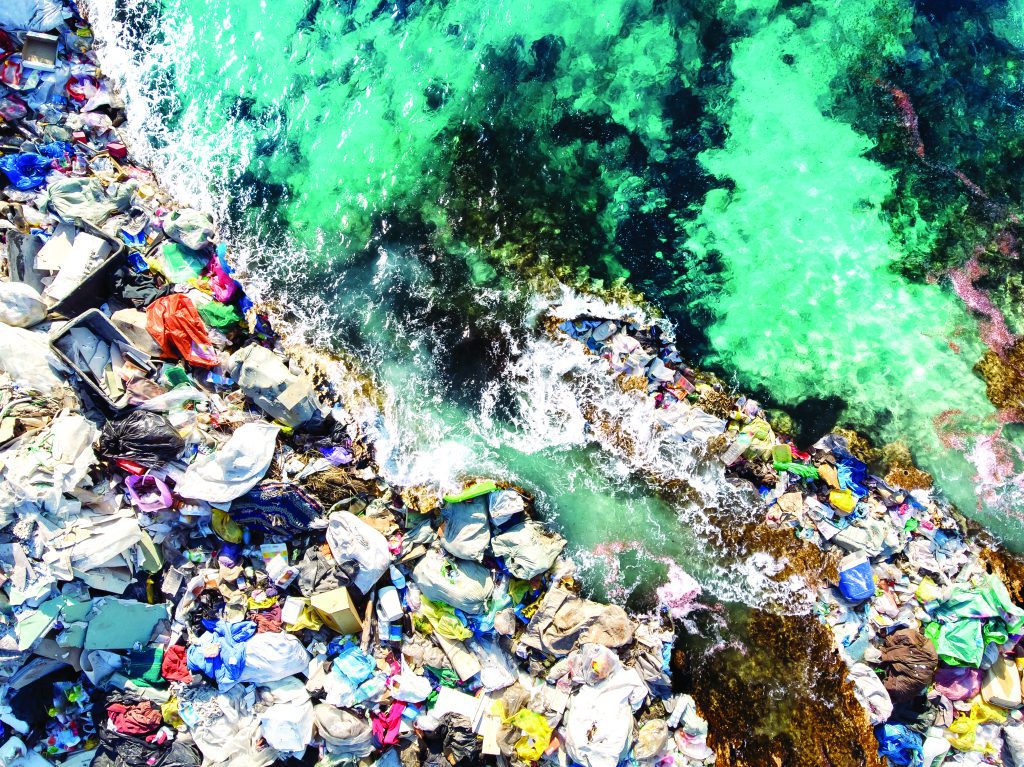Every year, humans produce 300 million tonnes of plastic waste, including 11 million tonnes of plastic waste that eventually winds up in the oceans. In fact, by 2050, there could be more plastics than fish in the ocean. Most plastics never disappear; instead, they become smaller, with particles being swallowed by fish and eventually consumed by humans in their food and tap water, according to a UN report of 2022.
India has 174,000 units of fishing gear in operation, of which 154,008 units are gillnets/ driftnets and 7,285 units are traps while the remaining are fishing lines. Of these, 15,276 tonnes of gillnets are lost from India per year, according to an FAO report of 2020.
Marine plastic pollution is a global menace. There is a need for regular and standardised monitoring of marine litter to understand long-term changes in marine litter pollution and for the successful development and implementation of mitigation strategies.
LAND-BASED SOURCES
It is estimated that the amount of plastic waste that entered the ocean in 2010 globally was from coastal populations living within 50 km of the coastline. Based on a fixed percentage of mismanaged plastic waste entering the oceans (15% for the low-range estimates and 40% for the high-range estimates), it was estimated that between 4.8 and 12.7×106 t of plastic entered the global ocean.
OCEAN-BASED SOURCES
Plastic waste can also emanate from ocean-based sources such as the fishing, commercial and recreational shipping, and offshore platforms. In 1988, the International Convention for the Prevention of Pollution from Ships (MARPOL) prohibited waste dumping from vessels.
MARINE PLASTICS SURVEY IN INDIA
Under the Coastal Ocean Monitoring and Prediction System (COMAPS) programme (one of the longest systematic ocean data collections for 3 decades) by ICMAM-PD, now the National Centre for Ocean Research of the Ministry of Earth Sciences, accumulation of marine debris was reported along the coast of Great Nicobar Island, Andaman. This accumulation might have been due to surface ocean currents prevailing, leading to the transportation of solid waste dumped by passing ships/ fishing vessels. This was the first Indian scientific publication on marine debris and subsequently, many more research papers have been published. It is reported that 8% of the total solid waste produced is plastic waste and the top three cities that contribute most to pollution are Delhi, Kolkata, and Ahmedabad. Plastic production in India increased by 39.7% and now stands at 9.46 million tonnes of plastic waste per year when five years ago it was 5.7 million tonnes per year. However, only 15% of the plastic waste produced is recycled in India and the rest is sent to landfills, incinerators, or dumped into the oceans and rivers. About 0.6 million tonnes of plastic waste ends up in oceans from India alone via rivers, surface run-off, etc. Rivers contribute to about 67% of the total marine plastic debris in the world. The Ganga originates from Western Himalayas and flows through four countries and discharges in the Bay of Bengal. The Ganga discharges about 105,000 tonnes of plastic waste into the Bay of Bengal every year.
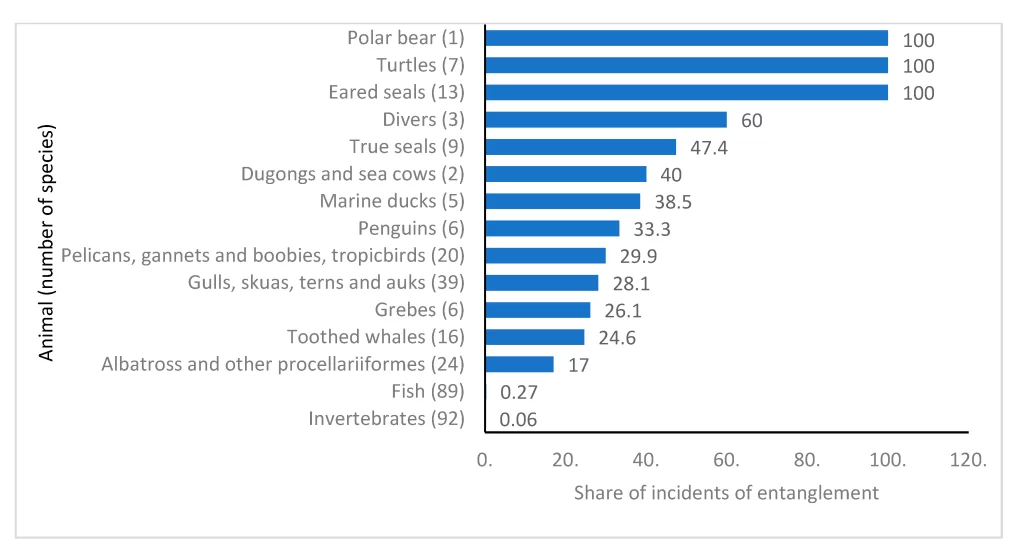
TAMIL NADU COAST
Tamil Nadu, which has a long coastline, stands second in plastic production in India. The plastic waste reaching through rivers and land run-off, and dumped ghost gear cause serious problems to the flora and fauna as well as to the livelihood of the fishing communities along the coast. The government of Tamil Nadu banned the usage of thin plastic (polymers of thickness below 40 microns). Despite such laws, Chennai is the major cause of plastic production in Tamil Nadu as it produces about 898,700 tonnes of plastic waste per year of which 57,000 tonnes per year is disposed of into the ocean. The major contributors to the discharge of plastic into the ocean are the Adyar and the Cooum rivers, which run through the heart of the city and account for 81% and 19% of total riverine discharge from Chennai, respectively. Thermocol (30.82%), plastic bags (28.30%), bottles & caps (13.84%), straws (12.83%), and food wrappers comprise macroplastic debris. Comparing these (8.97%) with data collected from about five years ago, there seems to be a 71.67% increase in plastic discharge into the ocean from Chennai alone. This alarming increase could be due to the increased usage of disposable plastics like masks, Covid protection kits, and home deliveries (plastic used for packaging is the major contributor to plastic waste).
Sea-based waste must also be taken into consideration. The fishing boats of Tamil Nadu can be classified as traditional (catamaran, dug-out canoes, plank-built canoes, masula boats, dhinghi, outrigger canoes, built-up boats) and mechanised (hand line boats, pole and line fishing vessel, trolling vessel, dol netter, gill netter, stern trawlers) and the major fishing gear types include gillnets, hook and line, shore seines and boat seines (FAO, 1983). No reliable sources are available to calculate the estimated ALDFG (Abandoned, Lost or other Discarded Fishing Gear) along the Tamil Nadu coast.
BIODIVERSITY – GULF OF MANNAR BIOSPHERE
The Gulf of Mannar is an important hotspot as it supports numerous marine life and provides a sense of economic security for Tamil Nadu due to its fisheries resources. It is situated in Tamil Nadu and extends from Rameswaram to Kanyakumari. Horst Graben structure, the prevalence of monsoon, two courses of drift in water currents, Cenozoic sedimentary functions and riverine processes make the Gulf of Mannar biosphere ideal for a lot of marine biota and stable marine ecosystems. Anthropogenic influences on the environment leading to pollution and climate change are the major causes of biodiversity degradation worldwide, which include ALDFG, untreated sewage and solid wastes from domestic and industrial sources.
ABANDONED, LOST, OR DISCARDED FISHING GEAR (ALDFG)
Abandoned, Lost, or Discarded Fishing Gear (ALDFG) is a serious problem worldwide but there is lack of data as well. Most of these wastes are due to shipping or fishing accidents, bad weather, etc., and while most of the lost gears are retrieved by the fishers, the little that remains causes serious problems to the marine ecosystems A lot of species are killed by these wastes, and since they do not decompose easily, they keep killing various organisms throughout their lifetime. About 20% of all the plastic debris in the oceans is from ALDFG according to UNEP. Globally, it is estimated that about 640,000 tonnes of ghost gears are disposed of into the oceans every year.
MICROPLASTICS
Plastics are made from non-renewable resources such as crude oil and hence they are hard to decompose as the polymers are bonded through covalent bonds, a strong bonding force. Microplastic is about 5 mm in diameter and is always disposed of into the environment through anthropogenic sources. They are particularly hard to locate, track and study as they are smaller than what the naked eye can see. Another major issue with microplastics is that they show a high affinity to other toxicants, making them more dangerous to the organisms ingesting them. The majority of the plastic debris (~94%) in the oceans disintegrates into microplastic while the remaining 6% remains as microplastic. The study of microplastics and their dynamics is, therefore, important.
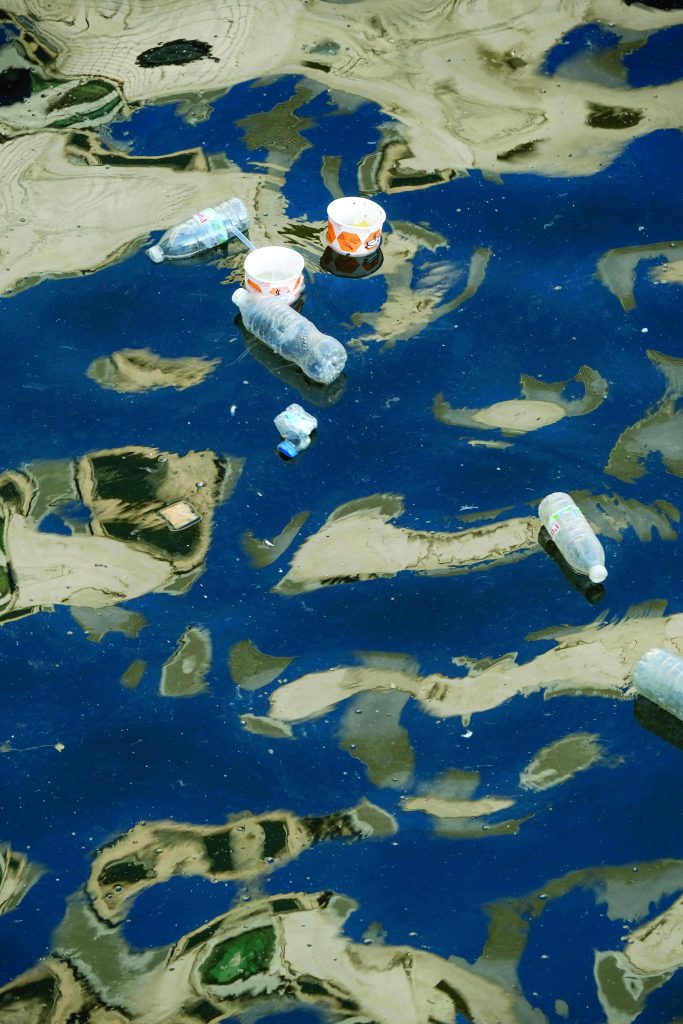
Image Courtesy: Pexels
Calculating the amount of microplastic entering the ocean can be challenging as they are small and the rate at which plastics degrade is unknown. Nevertheless, the abundance of microplastic from Chennai is found to be +/- 184 microplastic/kg of sediments and about 0.33 particles/l of water from Adyar river. Adyar river discharges about 11.6 trillion microplastic particles into the Bay of Bengal per year. Such a large discharge causes harm to the natural ecosystems and inevitably affects humans too. Microplastic abundance was studied, and it was found that the polymers PE (polyethylene or polythene) contributes to 46.7%, PP (polypropylene or polypropene) to 46.7% and PS (polystyrene) to 6.7% of all the microplastic. About 64 % are fibres, 22% films, 12% fragments and 2% pellets, of which 44% of them were black, 30.4% red, and 14.2% white. These are the types of microplastic discovered in the natural ecosystem so far.
Under the Marine Plastics survey programme of NCCR (National Centre for Coastal Research), the distribution of microplastics was studied in coastal locations in the Bay of Bengal and Arabian Sea in particular along the international shipping routes. This study showed microplastics are observed in almost all the sampled sites in the open ocean in the 100m mid-water column in all seasons. Compared to other transects, more microplastics were observed during pre-monsoon in Bay of Bengal and post-monsoon in Arabian Sea. The coastal locations in post-monsoon show three times lesser concentration than the Arabian Sea. Some samples had no plastics at a few locations in the Arabian Sea and in the Bay of Bengal. The most dominant type of microplastics found in the water column microfiber/ lines identified in the study are Polypropylene (PP), High-Density Polyethylene (HDPE), Low-Density Polyethylene (LDPE), and Poly(amide-6) (Nylon). Further, extensive sampling is needed to understand the vertical movement of the microplastics.
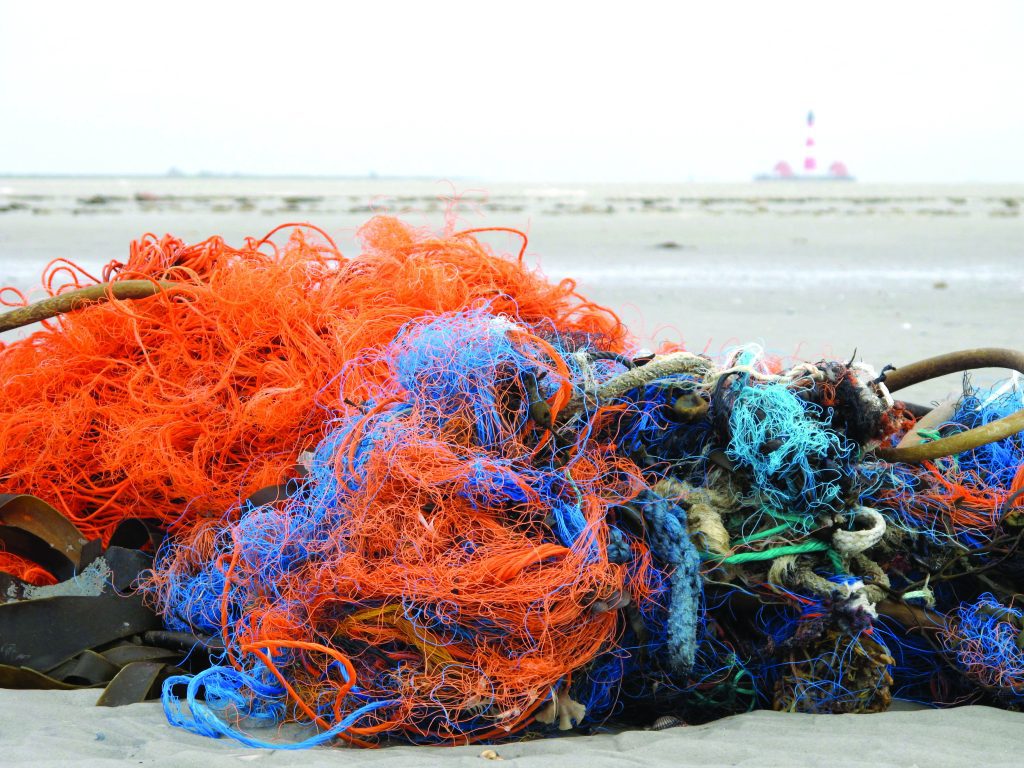
Image Courtesy: Flickr
One of the main plastics, polyethylene terephthalate (PET), is found in clothes and when these clothes are washed, small plastics known as microplastics are released. Biodegradation offers a method to remove and prevent a build-up of microplastics (and potentially a new recycling method). Biodegradation is a process by which enzymes break up a polymer (e.g., PET) back into its original monomer form. Global research focused on the use of plastic degrading enzymes is a promising future prospect in managing and recycling robust plastics such as PET.
SWACHH SAGAR, SURAKSHIT SAGAR
Commemorating the 75th year of India’s Independence, a coastal cleanup drive was carried out at 75 beaches across the country for 75 days over a 7500 km long coastline. The campaign began on 3 July 2022 and culminated with the largest beach cleaning event on 17 September 2022 (the International Coastal Clean-up Day). This drive was aimed at removing 1,500 tonnes of garbage from the seacoast which will be a huge relief to marine life and the people staying in coastal areas.
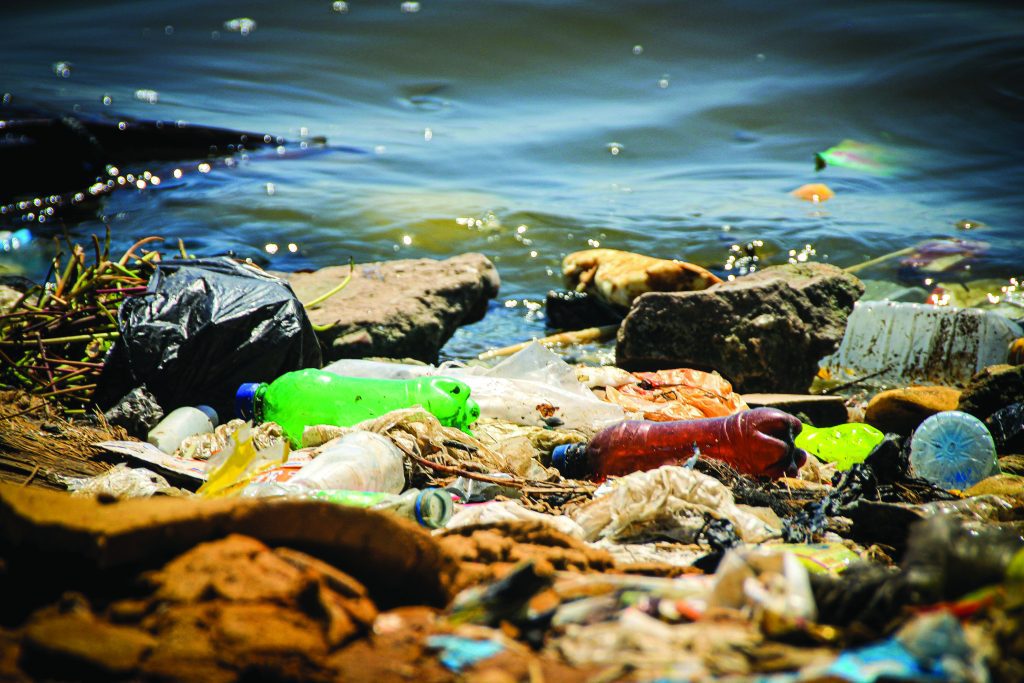
Image Courtesy: Pexels
Many industries employ plastic in various products due to its nature and ease of production. They have certainly helped in enhancing the efficiency of products, leading to a constant demand. While the petrochemical sector is regarded as the backbone of plastic production, it is also considered a yardstick for measuring global economic growth, wherein plastic processing and production are of vital importance. The volume of plastic waste has also grown over the years. Microplastics add to the harmful effects. The major challenge, however, is the segregation and re-aggregation of plastic waste streams such as packaging waste, including laminated plastic.
The biodiversity of India is unique, and steps must be taken to ensure its safety. Livelihood of millions depends on the biodiversity of India, so care must be taken to protect and boost environmental health. Plastic pollution is a concerning issue as consumption and discharge have increased but no steps have been taken to study, monitor, and reduce plastic usage. All this makes it necessary to find ways to reduce the usage of plastic because India needs diverse ecosystems to thrive.
*Akanksha Singh is a research scholar and RS Sengar is a Professor at the Department of Agriculture Biotechnology, College of Agriculture, Sardar Vallabh Bhai Patel University of Agriculture and Technology, Meerut. They can be reached at akkusingh1304@gmail.com and sengarbiotech7@gmail.com respectively.






